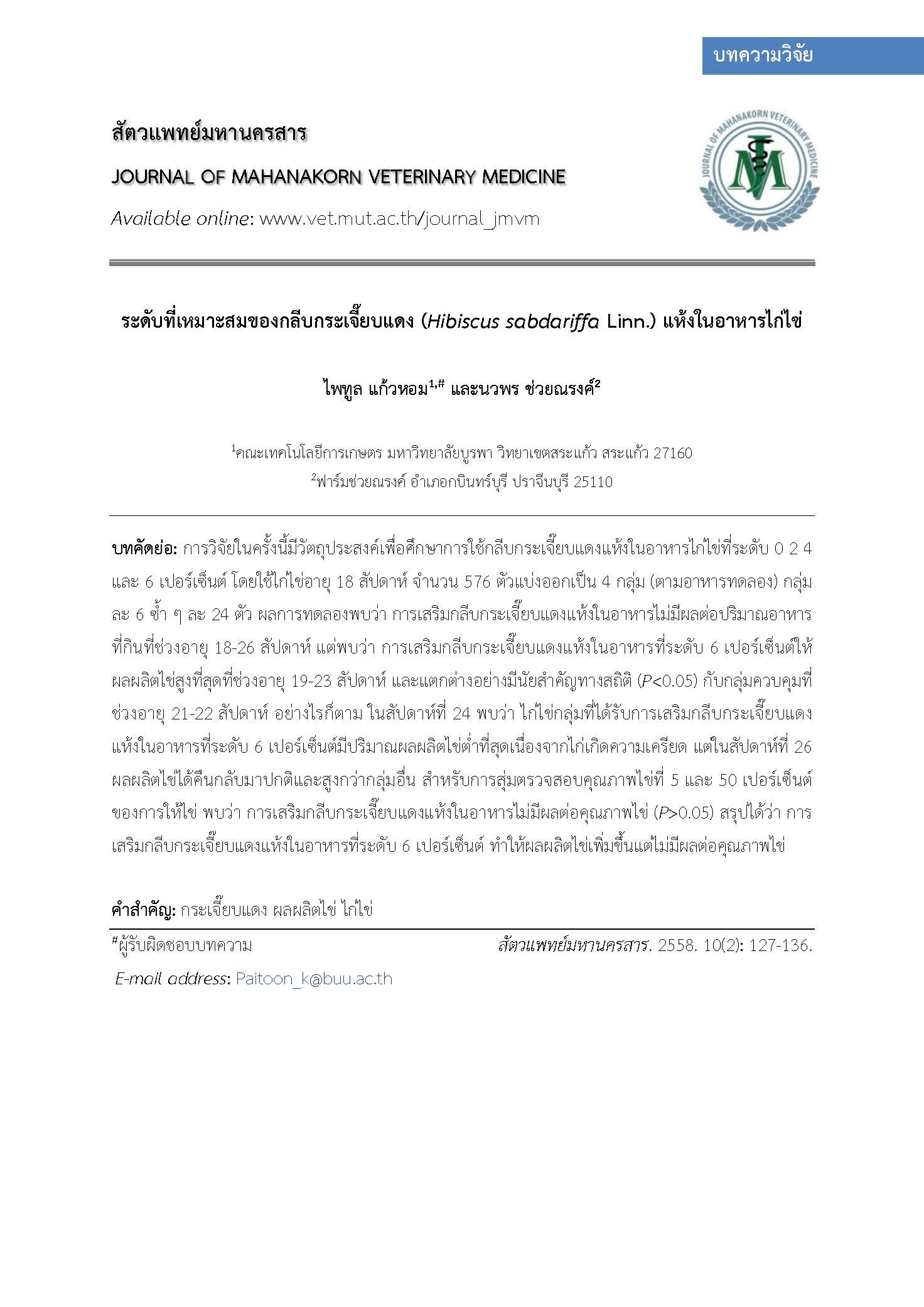The Optimum Level of Roselle (Hibiscus sabdariffa Linn.)
Main Article Content
Abstract
An experiment was conducted to examine the benefits of using roselle (Hibiscus sabdariffa Linn) dried calyx at varying levels (0, 2, 4 and 6%) in diets for laying hens at 18 weeks. Five hundred and seventy six 18-week old Hisex Brown pullets were randomly allotted into 4 groups of 6 replications, each replication containing 24 birds. Feed intake from 18 to 26 weeks of age was unaffected by the roselle supplement. From 19 to 23 weeks of age the highest egg production was observed in 6% roselle group. Inclusion of roselle at 6 % in the diet was found to increase (P<0.05) egg production at 21 and 22 weeks of age. However, at 24 weeks birds have the physiological stress, thus the lowest egg production was found in 6% roselle. By 26 weeks of age the egg production from birds in this group recovered and was higher than in other groups but this was not significantly different. Egg quality at 5 and 50% lay was not significantly different between the levels of roselle in diet (P>0.05). In conclusion, supplementation of 6% roselle calyx in chicken diets can improve egg production but it does not affect on egg quality.
Article Details
References
Aphirakchatsakun, W., Angkanaporn, K. and Kijparkorn, S. 2008. The Effect of Roselle (Hibicus sabdariffa Linn.) Calyx as antioxidant and acidifier on growth performance in postweaning pigs. Asian-Austral. J. Anim. Sci. 21: 574-581.
Doyon, G., Bernier-Cardou, M., Hamilton, R. M. G., Eastaigns, F. and C. T. Ramdald. 1986. Egg quality: Albumen quality of egg from five commercial strains of White Leghorn hens during one year of lay. Poult. Sci. 65: 63-66.
Klassing, K. C. 1998. Comparative avian nutrition. New York: CAB International: 350.
Kamei, H., Kojima, T., Hasegawa, M., Koide, T., Umeda, T., Yukawa, T. and Terabe, K. 1995. Suppression of tumor cell growth by anthocyanins in vitro. Cancer Investigation, 13: 590-594.
Kruawan, K. and Kangsadalampai, K. 2006. Antioxidant activity, phenolic compound contents and antimutagenic activity of some water extract of herbs. Thai J. Pharm. Sci. 30: 28-35.
McKay, D. L., Chen, C. Y., Saltzman, E. and Blumberg, J. B. 2010. Hibiscus sabdariffa L. tea (tisane) lowers blood pressure in prehypertensive and mildly hypertensive adults. J. Nutr. 140: 298-303.
Meiers, S., Kemeny, M., Weyang, U., Gastpar, R., Von Angerer, E. and Marko, D. 2001. The anthocyanins cyanidin and delphinidin are potent inhibitors of the epidermal growth-factor receptor. J. Agr. Food Chem. 49: 958-962.
Mgbenka, B. O. and Lovell, R. T. 1987. Digestibility of feedstuff and supplementary diets by grass carp. Nigerian J. Appl. Fish. Hydrob. 2: 65-71.
Minitab Inc. 1998. Minitab Release 12.1. Minitab Inc., State College, PA.
Nagase, H., Sasaki, K., Kito, H., Haga, A. and Sata, T. 1998. Inhibitory effect of delphinidin from Solanum melongena on human fibrosarcoma HT-1080 invasiveness in vitro. Planta Medica. 64: 216-219.
North, M. O. and O. O. Bell. 1990. Commercial chicken production manual 4th Edn. Van Nostrand Reinhold, New York. pp. 686.
Salih, F. I. M. and Abdel W. O. E. 1999. Utilization of roselle (Hibiscus subdariffa) seed meal in diets for growing broiler chickens. Sudan J. Anim. Prod. 3: 101-108.
Shiau, S. Y. 1989. Role of fiber in fish feed. pp. 93-119. In: Shiau, S.-Y. (Ed.). Progress in Fish Nutrition: Proceedings of the Fish Nutrition Symposium, Marine Food. Science Series No. 9, National Taiwan Ocean University, Keelung, Taiwan.
Sukkhavanit Piyaphon. 2008. The effects of Roselle (Hibiscus Sabdariffa Linn.) calyx in laying diet on antioxidation, egg quality and shelf life of egg. A Thesis submitted for the Degree of Master of Science. Chulalongkorn University, Bangkok, Thailand.
Sukkhavanit, P., Angkanaporn, K. and Kijparkorn, S. 2011. Effect of Roselle (Hibiscus sabdariffa Linn.) calyx in laying hen diet on egg production performance, egg quality and TBARS value in plasma and yolk. Thai J. Vet. Med. 41: 337-344.
Tsai, P. J, McIntosh, J., Pearce, P., Camden, B. and Jordan, B. R. 2002. Anthocyanin and antioxidant capacity in Roselle (Hibiscus sabdariffa L.) extract. Food Res. Int. 35: 351-356.


